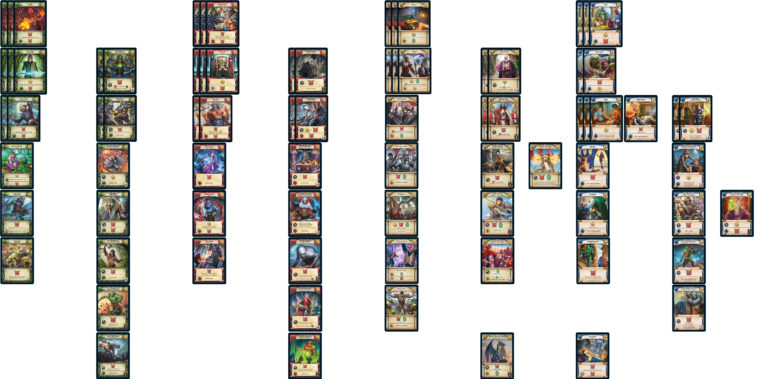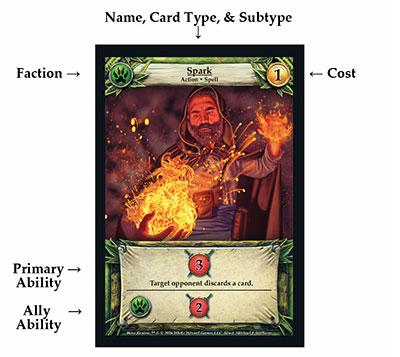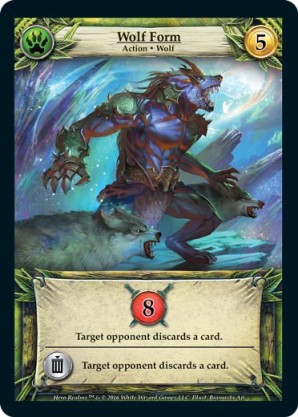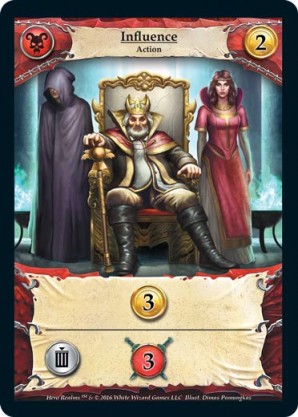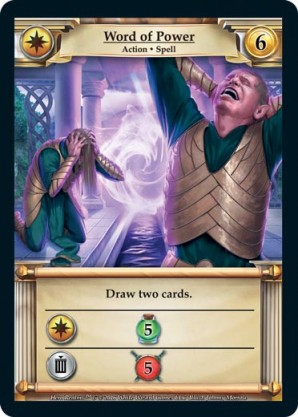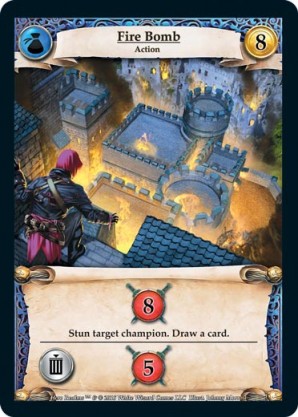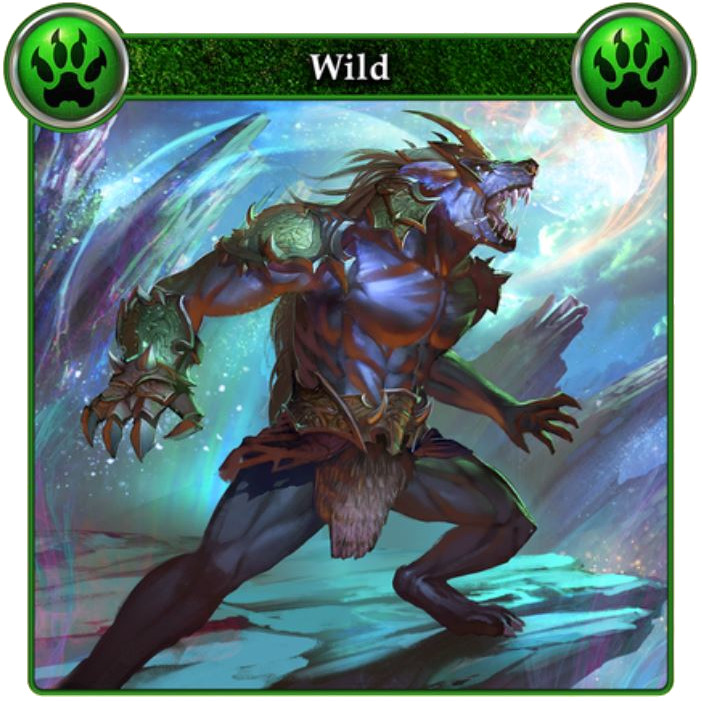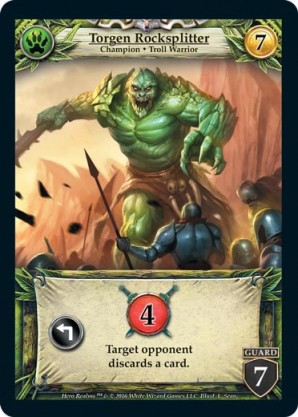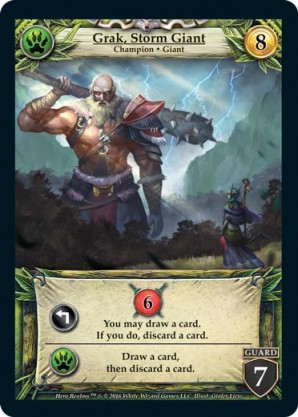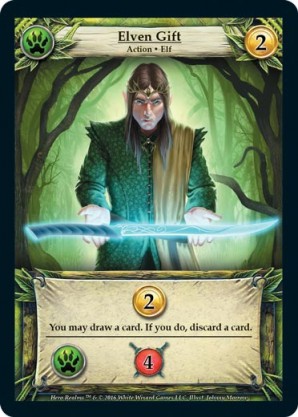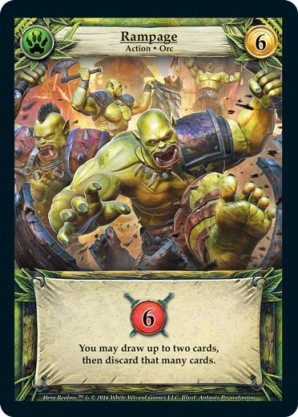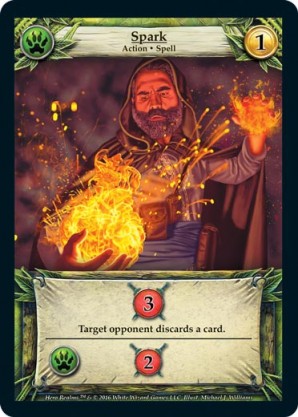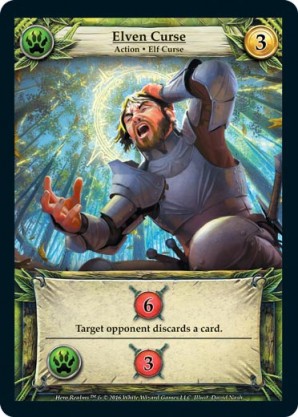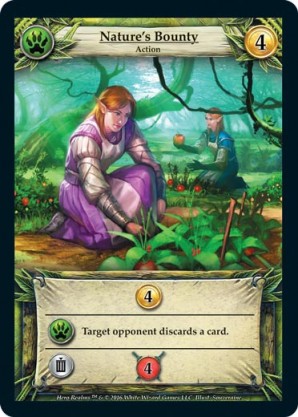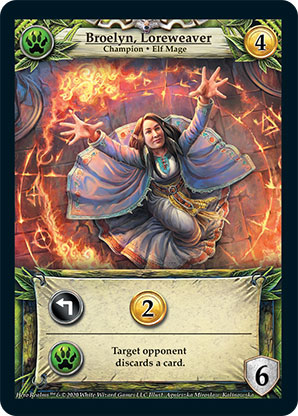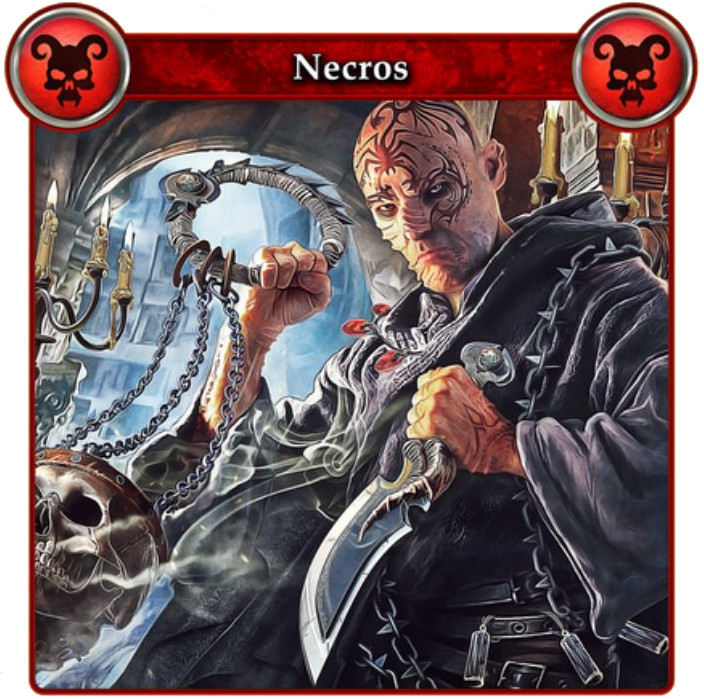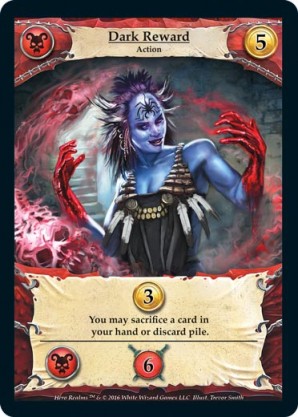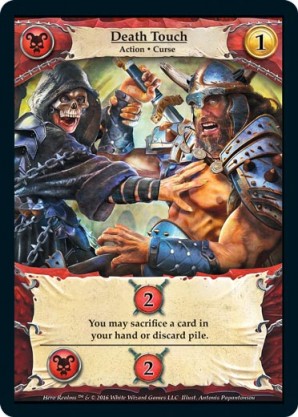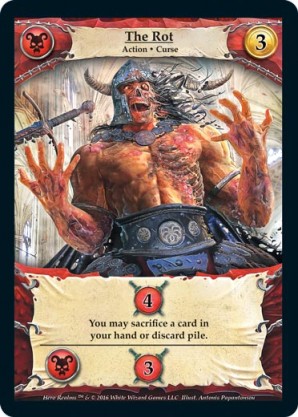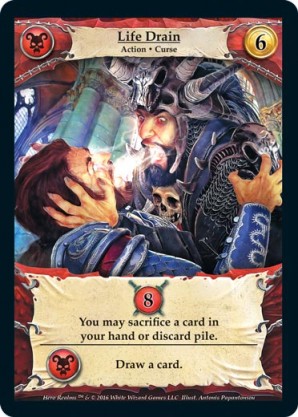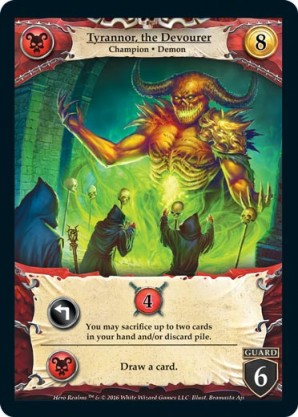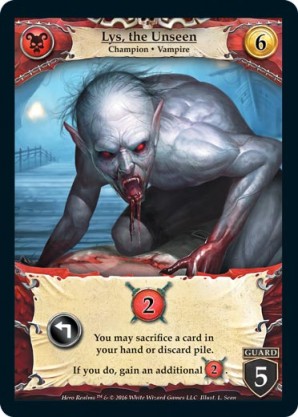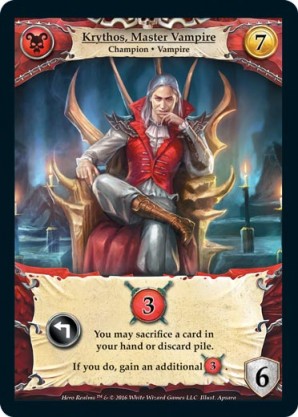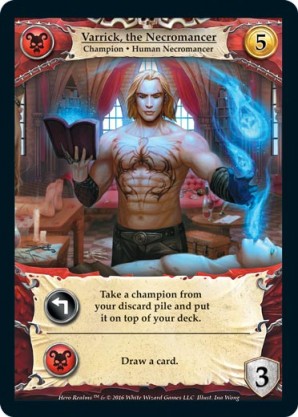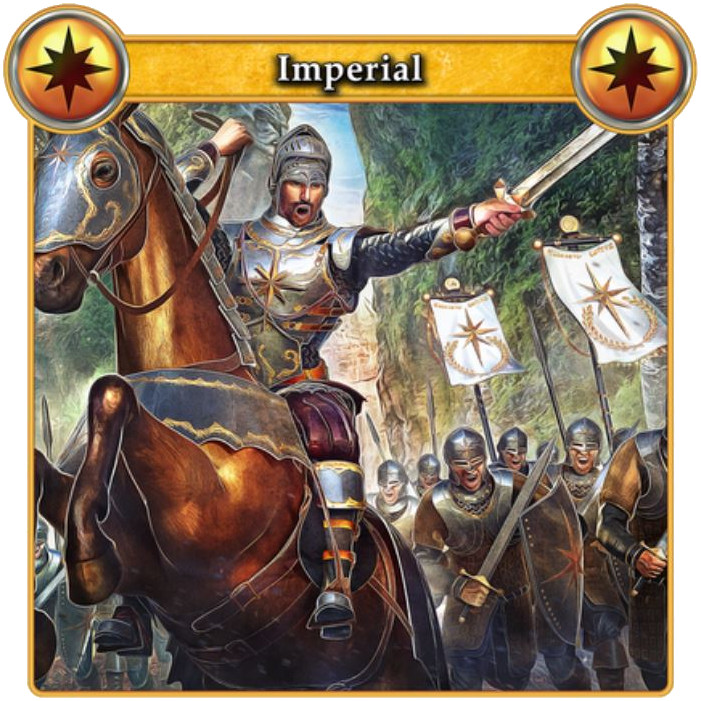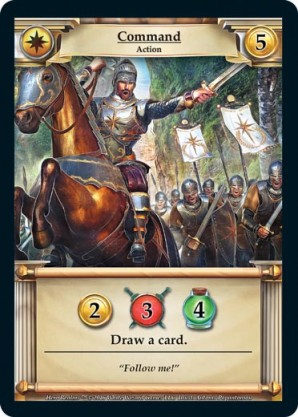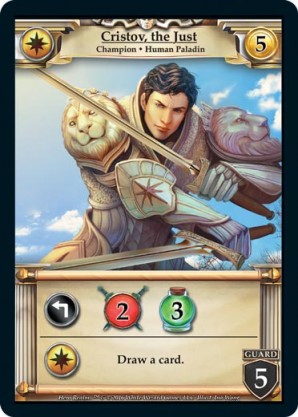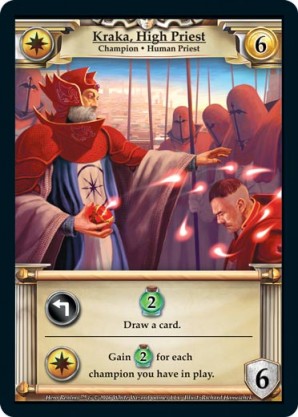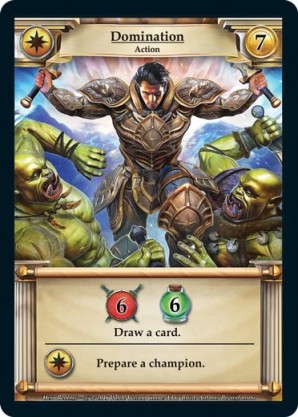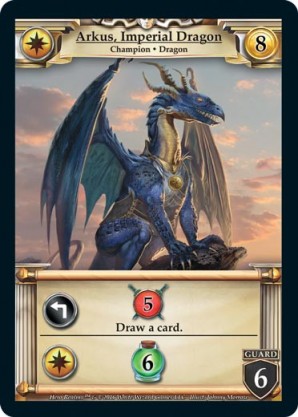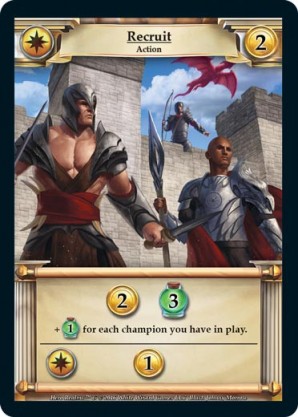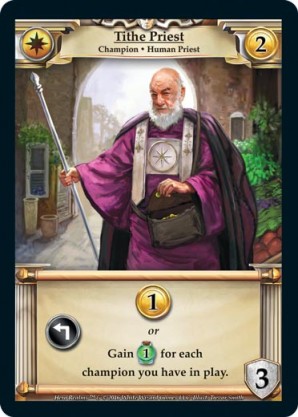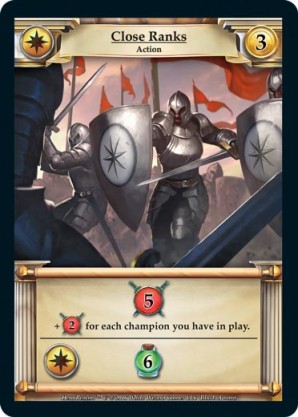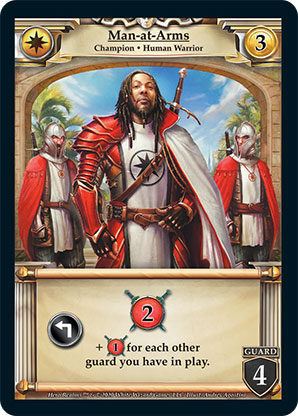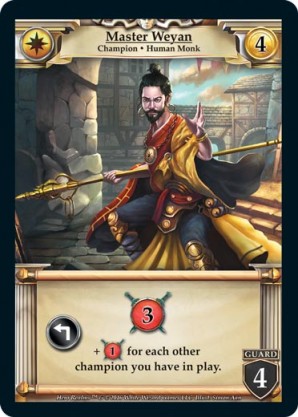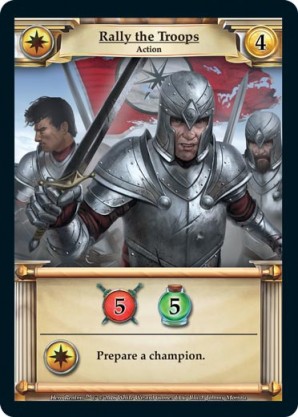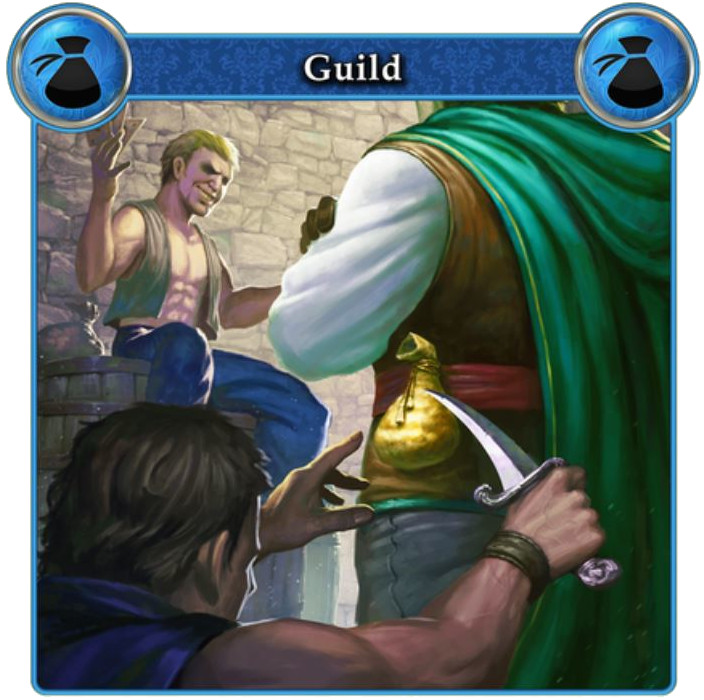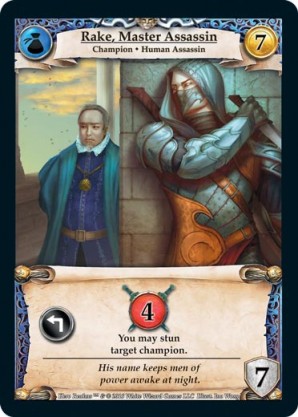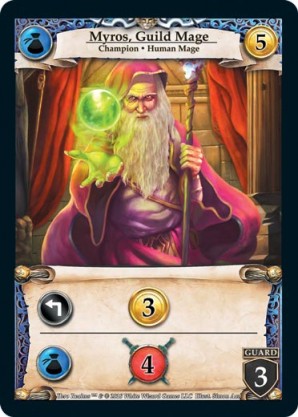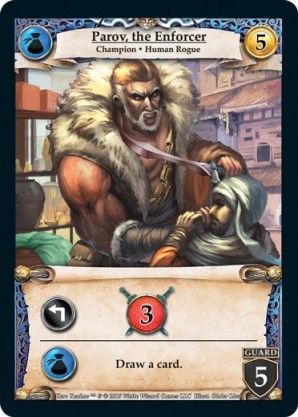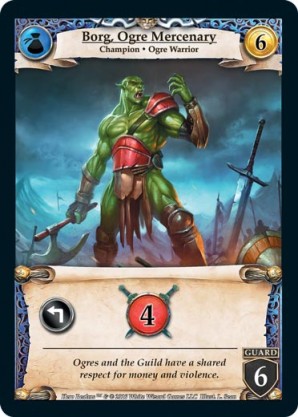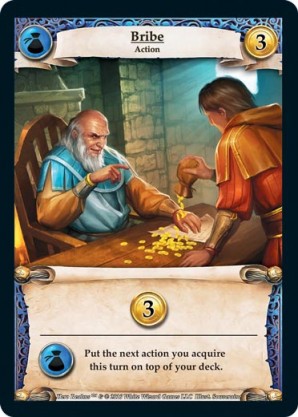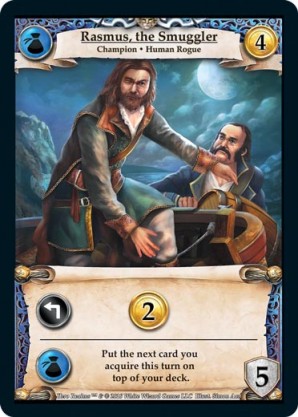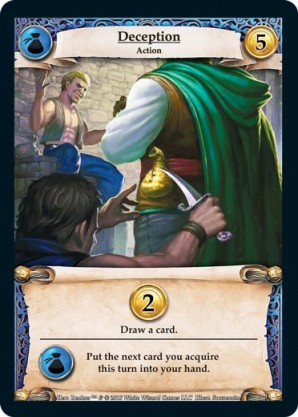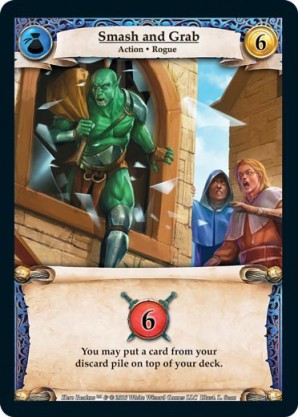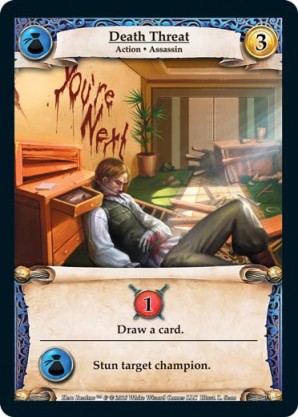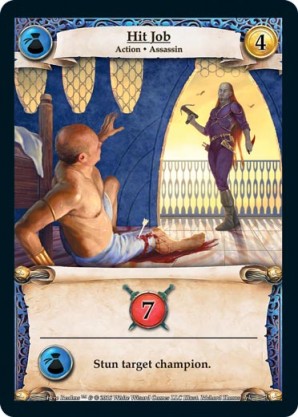For a millennium, the Empire was at war. Fueled by military precision and an unprecedented alliance with Dragons, the Imperial Armies knew countless victories and defeats. The Empire grew until its greatest enemy was not any of the barbarian nations to the east, but its own unmanageable size. At the frontier, victories and expansions were replaced by an endless cycle of rebellion and re-conquest.
Weary of war, the Emperor craftet a bold new strategy: Peace through trade. One hundred and seventy years ago, he ordered the establishment of Thandar, an independent frontier trading post at the junction of the four great rivers.
Though many argued peace with the wild tribes was impossible, trade flourished and the trading post quickly grew to a town, then into a small city and beyond…
Hero Realms is set in the sprawling metropolis that Thandar has grown into. The city-state is now home to folk from all the species and nations of the known world. While Thandar’s trade has delivered its promised peace to nations, the wealth generated by its trade spurs endless political and physical conflict amongst its residents…
Lore from Hero Realms Kickstarter
Among the cards that make up the Market Deck in Hero Realms, there are four different factions. The Wild (green), the Necros (red), the Imperial (yellow) and the Guild (blue). These factions co-exist within the city of Thandar and each have their own way of getting things done.
Each faction consists of 20 cards divided among actions and champions. Note that this also means that there is not a single item in the market deck.
Between the factions there are a few similarities right off the bat.
The Wild and the Necros faction have the exact same structure-build between actions, champions and cost. The only difference between these two structures is the defense value of their champions.
This seems to be the default structure of the factions, because although the Imperial and the Guild factions have been tweaked a little, there are still some things that are similar. For instance, every faction has three 1-cost actions, two 3-cost champions, one 4-cost action, one 5-cost action, one 6-cost action, one 6-cost champion and only a single 7- and 8-cost card. In addition, every faction (except the Guild) has 11 actions and 9 champions in their build.
Every card has a primary (or main) ability and in addition most cards also have an ally ability that is triggered, only if another card of the same faction is in play within the same turn.
It is important to remember, when talking deck building, that since ally abilities are harder to trigger, they shouldn’t be valued as highly as the main ability. They can however come to be quite valuable indeed, if the player builds heavily into that faction. Just know that the Market Row is a cruel mistress and that she will screw you over as often as possible.
Often players will build towards at least two factions at the same time – eventually also adding in a few strong cards from other factions – which unfortunately drops the value of those ally abilities.
A few cards also has a sacrifice ability that will allow the player to trash the card for extra value once the relative usefulness of the card’s other abilities has played out.
This ability should count as the least amount of value, since it is only triggered once. But it is important to keep in mind that trashing a card also means thinning out the deck, which again means shortening the deck cycle for the rest of the cards in the deck.
Every faction has some amount of the basic resources of the game – Gold, Damage, Draw and Defense (see the end of the article for a schematic overview between factions). Gold is most often found on cheaper cards, while the expensive cards focus more on putting an end to the game and often brings damage and special abilities. Every faction also has a special set of abilities to set it aside from the others and to provide a variety of deck building strategies.
So let’s have a look at the factions.
Elven kingdoms older than recorded human history, ravaging orc war hosts, savage nomadic human tribes, trolls and deadly wild beasts can all be found in vast wild lands east of the Empire.
Art and lore from Hero Realms Kickstarter
Wild faction Basic Resources
| Main | Ally | Trash | Total | |
|---|---|---|---|---|
| Gold | 12 | 12 | ||
| Damage | 631 | 24 | 4 | 91 |
| Draw | 3 | 3 | ||
| Non-guard | 20 | 20 | ||
| Guard | 25 | 25 |
Wild faction Special Abilities
| Main | Ally | Trash | Total | |
|---|---|---|---|---|
| Cycle | 6 | 1 | 7 | |
| Discard | 7 | 2 | 1 | 10 |
The Wild faction is the most aggressive of all of the factions and it deals a lot of damage. It has the highest damage potential (91 damage) among all of the factions. This total is variable with the Wolf Shaman though, which deals 1 extra damage per other Wild card in play. There are two copies of this in the faction and although it is kind of weak on its own, if a player has built heavily into Wild, they definitely want to pick this up too.
The Necros cult follows closely behind with 87 total damage, but there are a couple of differences. Almost 70% of the Wild faction’s damage comes from main abilities alone, whereas the Necros faction only has about 60% from main abilities. The Wild also has the lowest amount of Trash-damage among all factions (4 Wild vs 9 Necros). If we ignore the trash damage, as it is only usable once, the gap between the two factions rises to 9 damage.
Despite its high damage-count, it is also the faction with the most defense overall – making the Wild faction attractive to aggro-happy and defense-building players alike. The Wild has a total of 45 defense, while a faction like Imperial only has 40.
The non-guard defense is exceeded only by the Necros (with one measly point of defense) and it is the faction with the highest amount of guard defense (25 defense, followed by the Imperial’s 23). This is largely due to the fact that the Wild is the only faction with guards as both their 7- and 8-cost cards.
The Wild falls behind on gold. It is the faction with the lowest gold count in the game with only 12 gold total. This is close to the Necros (14 gold), but miles away from the Guild (28 gold). So while it is possible to build an entire deck with only Wild cards, it is almost never going to happen.
The draw potential of the faction is also the lowest among all the factions with only 3 draws total and all of them being ally abilities. But this leads us to talk about one of the Wild’s special abilities.
As the only faction in the game, the Wild has the ability to draw a card and then discard a card, potentially discarding a weaker starter card and gaining a bomb. There are 5 cards in the Wild faction that carry this ability and only on Grak, Storm Giant has it been downgraded to an ally ability (along with it also being part of his main ability).
We call this; cycling through the deck, and it means that the player will be able to flip their deck faster – making sure that those strong cards make their way into their hand more often. Switching out weak cards for better ones is a strong ability. It isn’t as strong as a straight up draw, as there might not always be a weak card ready to discard, but it is still up there.
It is important to remember though that the ability only allows to discard from hand. If there are no cards in hand when using this ability, the drawn cards will automatically be discarded. But unlike a draw – cycling isn’t mandatory. So if a player has a cycle card in hand, but doesn’t gain value by using it, they can just choose not to do so.
The Wild is also the only faction of the game that allows the player to manipulate their opponent’s deck – essentially trolling them (sorry about the pun, Torgen Rocksplitter). It forces the opponent to discard a card from their hand – making it more difficult for them to trigger ally abilities or just to gather enough gold for an expensive card or enough damage to take out a champion wall. This ability is built heavily into the faction with 10 discards overall (7 of those as main abilities), making it possible to force several discards within a single turn.
The Necros Cult festers in the city’s underbelly, preying on the homeless, the forgotten and any that dare challenge them. The necromancers, vampires and cultists that fill the ranks of the Necros have been granted dark powers from the demons they worship.
Art and lore from Hero Realms Kickstarter
Necros faction Basic Resources
| Main | Ally | Trash | Total | |
|---|---|---|---|---|
| Gold | 141 | 14 | ||
| Damage | 521,2 | 26 | 9 | 87 |
| Draw | 5 | 5 | ||
| Non-guard | 21 | 21 | ||
| Guard | 17 | 17 |
Necros faction Special Abilities
| Main | Ally | Trash | Total | |
|---|---|---|---|---|
| Sacrifice | 11 | 11 | ||
| Manipulation | 1 | 1 |
The Necros faction is not the best at anything. On the other hand, it isn’t the worst at anything either. It is very similar to the Wild faction in build with a high damage potential and a low gold potential, but they are by no means identical factions.
Although the Necros can’t keep up with the Wild in damage, it does follow close behind with a total of 87 damage overall (including the 1 extra damage from the two Cult Priests). This is 19 damage more than the 3rd runner up (the Guild) and a whopping 35 more than the Imperial. Quite a lot of this damage has been placed as an ally ability though, so the faction encourages the player to buy more Necros cards to realize its full damage potential. If we disregard the ally and trash abilities; the Necros faction (52 damage) is much closer to the Guild (47 damage) and the Imperial (also 47 damage) than it is to the Wild (63 damage).
The Necros actually has the highest non-guard defense among all factions with 21 defense – barely scraping ahead of the Wild and the Guild which both have 20 non-guard defense. It is pulled down to a 3rd place in total defense though by its poor guard-defense (17 defense) – leaving it with 38 total defense and beating only the Guild (34 defense).
This is a bit puzzling, because the structure of the build is so similar to that of the Wild, which has the highest defense. The difference is that – with the notable exception of the Cult Priest – the champions’ defenses are consistently 1 to 2 points lower than their Wild counterparts. Here I would like to encourage you to scroll back to the image with all the factions at the top of this article and make the comparison for yourself step by step. Trust me. It really drives the point home.
To say that the faction has plenty of gold would be untrue since it only has a total of 14 gold, which is half the amount of the wealthiest faction (Guild 28 gold). But to counter this, the gold that the Necros actually have is dealt out in bigger piles. With the exception of the Cult Priest, the Necros’ gold is given in pools of 3 gold at the time. This allows the player to gather the same amount of gold with fewer cards. In comparison, the Wild faction only has a single card (Nature’s Bounty) that deals out more than 2 gold at a time and the Imperial has none. Important to note is also that the faction’s three 2-cost Influence can be trashed at any time to deal damage and thin the player’s deck.
The Necros has no main ability draw effect although it has five placed as ally abilities. This is better than the Wild that only has 3, but still far worse than the Imperial, which has 6 main ability draws alone. In a thin, heavy-Necros deck, it might do better than the Guild’s 3 main and 1 ally, but it’s not a clear-cut call which faction wins this one as it comes down to coincidences.
The thing that makes up for all of the mediocracy above, is the Necros faction’s special ability. Exactly half of the 20 cards in this faction carry its special ability and it allows the player to sacrifice a card from their hand or discard pile (and in the case of the 8-cost Tyrannor, the Devourer – 2 cards). Sacrificing a card means removing it completely from the deck and it is very useful. It is often used to remove start-deck gold, but can be used for any card that doesn’t serve its purpose anymore.
By sacrificing cards that no longer hold the best value of the deck, the player is growing the relative value of the remaining cards because they will appear more often. We also call this ‘thinning the deck’ and by doing so, it not only ensures better value from each draw, but it also becomes easier to trigger those pesky ally abilities.
The thinner the deck – the better the value of remaining cards, so having several of these sacrificing abilities in a deck is a valid strategy. And since every single one of the 11 sacrifice abilities are main abilities – these cards are useful in any deck. Often players will prioritize sacrificing from their discard pile over their hand because it allows them to get the value out of the card one last time, but sacrificing from hand is a viable option in several cases and should never be discounted.
The 6- and 7-cost champions of the Necros faction (Lys, the Unseen and Krythos, Master Vampire) have a second ability built into their sacrifice ability. They allow for a player to gain additional damage – if they sacrifice something with these champions.
Compared to other factions, the damage from these high-cost cards (without sacrificing something) is less than ideal (2+3 Necros vs 5+4 Wild and 4+4 Guild). Therefore it might be a good idea to plan for this type of sacrifice ahead of time as the damage with a sacrifice is upped to 4+6 – making it more aggressive than even the Wild faction’s combo. Because of this, sacrificing with these cards should also always be prioritized over sacrificing with other cards.
Where the other factions have two fully fledged special abilities, the Necros faction has sacrificing – and Varrick, the Necromancer.
Varrick is a 5-cost, non-guard champion with 3 defense, no gold and no damage. At first glance he seems less than appealing, but his main ability is to manipulate the deck and pull a champion from the discard pile and put it on top of the deck. If he is paired with another Necros card, he is even able to trigger his ally ability and straight up draw the champion back to hand – essentially bringing it back from the dead.
It goes without saying that in a deck with no champions, Varrick is almost useless. But if Varrick is built into a heavy-champion deck… Magical things can happen. Especially if he is able to hide behind a strong guard or two so that he won’t be stunned and can use his ability every turn.
While at peace with its barbarian neighbours to the east, the Empire still clings to its military traditions. Its highly-trained soldiers, reality-bending wizards and deadly dragons comprise the best fighting force the world has ever known.
Art and lore from Hero Realms Kickstarter
Imperial faction Basic Resources
| Main | Ally | Trash | Total | |
|---|---|---|---|---|
| Gold | 16 | 3 | 19 | |
| Damage | 471 | 5 | 52 | |
| Draw | 6 | 1 | 7 | |
| Non-guard | 17 | 17 | ||
| Guard | 23 | 23 |
Imperial faction Special Abilities
| Main | Ally | Trash | Total | |
|---|---|---|---|---|
| Heal | 481 | 411 | 89 | |
| Prepare | 2 | 2 |
The Imperial faction is the faction with the best draw capabilities. It has a total of 6 draws on main abilities alone and can faction for an additional 1. Main ability draw is not common, so the fact that Imperial has 6 of them is huge. It is double the draw effect of the Guild (3 main ability draws), while the Wild and the Necros doesn’t even have a single main ability draw.
The draw effect is placed on the six most expensive cards of the Imperial faction, which means that it is usually a lot more than a simple draw that will be added to the deck with the purchase. It also means that it might take a while for the player to be able to purchase them.
A main ability draw makes the card transparent, which means that it doesn’t thicken the deck as normal. It doesn’t affect the ability to trigger ally abilities and other such things, because it replaces itself once played. Having a transparent card that also adds ressources or even special abilities to the player is a powerful thing.
The Imperial is the 2nd wealthiest faction with 19 gold. This is not an obscene amount of gold (like the Guild with 28 gold), but it is decent and better than the two other factions (Necros 14 and Wild 12).
It has the lowest damage potential among all factions with only 52 total. That is 16 less than its closest competitor the Guild (68 damage). There is a redeeming factor though. 90% of that (47 damage) is main ability damage, which puts it on par with both Guild (47 damage) and Necros (52 damage). It is the only faction with this high a main ability percentage (Wild 69%, Guild 69% and Necros 60%). In fact the Imperial doesn’t have a single damage placed as an ally ability and only a single card with damage as a trash ability.
As will be evident in a moment when we move on to special abilities, the Imperial faction is all about champions. So it isn’t surprising that they have a lot of defense built into their faction. It hasn’t got enough to take 1st place in defense, but this is largely due to their 7-cost card, which is an action instead of a champion. This is the only 7-cost action among all factions.
So in both guard-defense (23) and total defense (40), they take 2nd place. But it is the faction with the highest percentage of guard-defense overall. It has 58% guard-defense vs. Wild 56%, while Necros (45%) and Guild (41%) aren’t really even in the running for this. The Imperial’s 8-cost card is also a guard, although with a lower defense than its Wild counterpart – possibly because of the built in draw effect.
It is also the only faction with two 4-cost champions instead of one. This seems to have been traded in for their second 3-cost action, which it is the only faction lacking. The one 3-cost action that it has been left with (Close Ranks), does seems to have been strengthened a little though.
The Imperial faction has several cards that add additional value, if they are played alongside champions. This is interesting, because it isn’t really a special ability, although it still sort of feels that way. Instead the cards mirror the effect given by the Wild’s Wolf Shaman.
What is a special ability though is the ability to prepare a champion. When a champion’s main ability has been used, it becomes expended and cannot be used again until the player’s next turn. This ability however re-prepares the champion, making it possible to use a certain main ability twice inside a single turn. The ability doesn’t allow the player to use any ally abilities again though.
There are only two cards in the faction that carry this ability and both do it as an ally ability, which means that the player is forced to buy several Imperial cards if they hope to make use of this ability and only in very rare decks will it be possible to use it consistently. It is however a possible route for the Imperial faction to gain a little additional damage into their deck.
The biggest difference between the Imperial and the other factions, is the fact that it is able to heal the player – which means adding health to their life-total. 17 out of 20 cards in this faction have the ability to heal the player in some way, which walks the line between this being a special ability or simply a new game mechanic.
The faction is able to heal 48 points on main abilities alone and can faction for an additional 41 points. This is 89 points of healing within a single faction. It is almost enough to nullify even the Wild faction’s damage potential of 91. Keep in mind that the total amount of healing is variable with the number of champions in play. These numbers have been calculated with an average of 3 champions in play at the time.
The high healing potential is dependent on a lot of champions and ally abilities, so it will require a well built deck to reach those numbers. But the healing ability is definitely a way to break the aggressive play style of some of the other factions and caters well to players who enjoy taking the game a bit longer in an effort to hit some of the more interesting pairings.
The fortune in trade that flows through Thandar has fueled a powerful organized crime syndicate known as “The Guild”. The Guild has its hand in everything from petty street crime, to bribery or blackmail of political figures, to assassinations of those who would interfere with profits.
Art and lore from Hero Realms Kickstarter
Guild faction Basic Resources
| Main | Ally | Trash | Total | |
|---|---|---|---|---|
| Gold | 241 | 4 | 28 | |
| Damage | 471 | 16 | 5 | 68 |
| Draw | 3 | 1 | 4 | |
| Non-guard | 20 | 20 | ||
| Guard | 14 | 14 |
Guild faction Special Abilities
| Main | Ally | Trash | Total | |
|---|---|---|---|---|
| Stun | 2 | 2 | 4 | |
| Manipulation | 1 | 5 | 6 |
The Guild faction is the faction with the highest amount of gold. From main abilities alone the Guild has 22 gold available and they can faction for an additional 4 gold. In addition the Guild also has two copies of the champion Street Thug that allows the player to choose between 1 Gold or 2 Damage. Adding all of this together (28 gold), it is 9 gold more than Imperial (19 gold), which is the second wealthiest faction and double or more the amount of both Necros (14 gold) and Wild (12 gold).
It has a fair amount of damage potential despite its high gold count. Its main ability damage total is 43 plus the possible 4 damage from the Street Thugs. That is very close to that of the Necros faction (47 Guild vs 52 Necros), although it falls further behind in the overall damage total (68 Guild vs 87 Necros).
The draw/cycle ability is the lowest among all the factions with only 4 draws – 1 of those 4 even being an ally ability. Though there is a case to be made for Guild draws being more consistent than Necros draws, since all 5 draws in the Necros faction are ally abilities.
It is also the only faction to differ from the “11 actions, 9 champions”-build that the others have, making it the most action-heavy faction of all with 13 out of 20 cards being actions. Because of its heavy action build, the Guild is the lowest ranking faction in champion defense with only 34 defense (its closest competitor is the Necros’, which has 38 defense). Despite this, the Guild still has a total of 20 non-guard defense – which is on par with Wild (20 defense) and Necros (21 defense).
Where it falls behind is on guard defense with only 14 defense. Like every other faction, the Guild only has one 7-cost and one 8-cost card. It is interesting though that as the only faction, the Guild’s 8-cost card is an action and not a guard. Even the 7-cost is only a non-guard champion.
It’s also noteworthy though that what little guard defense the Guild actually has, is placed on only three champions total. The Guild has no cheap guards like the other factions. Their three guards are their two 5-cost and their 6-cost champion.
It is the only faction that doesn’t have any 2-cost champions. Every other faction has 2 identical champions at this level (Wolf Shaman, Death Cultist and Tithe Priest). The Guild has only two 2-cost actions in opposition to 3 in all of the other factions. To counter this, it has been given an extra 3-cost action (Bribe) and also (as the only faction) a second 3-cost action – Death Threat – which also is the cheapest card in the entire Market Deck with a main ability draw.
The Guild’s speciality is misdirection and – well basically – cheating. It has several special abilities to topdeck or pull to hand, which strengthens the player’s deck by shortening the deck cycle for those choice cards. Almost all of these are ally abilities though and requires the player to buy several Guild cards to up the chance of realizing one of these combinations inside a single turn.
The Guild is also the only faction to have abilities to stun an opponent’s champion without dealing damage. This attempts to balance out the below-average ranking in damage count, but it is important to remember that this ability only shines if the opponent is actually buying champions. Against a champion-heavy deck though, these abilities are potentially very strong as they can stun a 7-defense guard without even breaking a sweat.
The cheap stun-abilities come as ally abilities, while the Guild faction’s 7- and 8-cost cards (Rake, Master Assassin and Fire Bomb) have it built in as a main ability. But as Rake and Fire Bomb only carry half of the stun abilities and since it might be a while until a player is able to buy these, the stun ability (like the deck manipulating ability) also pushes the player to buy into more Guild cards if they want to trigger this ability consistently.
Now that you have gotten a full overview of the factions and different special abilities of the market deck, we return to the city of Thandar:
It’s early evening at the Inn of Four Rivers and the place is crowded with humans, elves and a dozen more races, all eating, drinking, singing and shouting. You’re seated at your usual spot in the back corner; enjoying a horn of ale and wondering what to have for supper; when a crash and clatter from near the door turns your head.
You see an upended table, broken dishes and spilled drinks, as well as an angry looking dwarf shoving an equally furious orc. You watch with only mild interest – fights are common at the Four Rivers.
Then you notice the smoke …
Lore from The Ruin of Thandar Campaign
Let the adventure begin!
If you enjoyed this article – check out Ep. 15 of the Realms Rising podcast where Anvroser and Thee Mystic spend some time discussing it!
Comparisons of Basic Resources
Below are schematic comparisons of the basic resources in Hero Realms.
Remember, this is not a static comparison. There might be slight differences in the values due to the build of each deck. The values have been copied directly from the tables found under each faction above and it is important to take into consideration the notes that have been associated with Gold and Damage in these tables due to special card abilities.
Gold
| Main | Ally | Trash | Total | |
|---|---|---|---|---|
| Wild | 12 | 12 | ||
| Necros | 14 | 14 | ||
| Imperial | 16 | 3 | 19 | |
| Guild | 24 | 4 | 28 |
Damage
| Main | Ally | Trash | Total | |
|---|---|---|---|---|
| Wild | 63 | 24 | 4 | 91 |
| Necros | 52 | 26 | 9 | 87 |
| Imperial | 47 | 5 | 52 | |
| Guild | 47 | 16 | 5 | 68 |
Draw
| Main | Ally | Trash | Total | |
|---|---|---|---|---|
| Wild | 3 | 3 | ||
| Necros | 5 | 5 | ||
| Imperial | 6 | 1 | 7 | |
| Guild | 3 | 1 | 4 |
Defense
| Non-guards | Guards | Total | |
|---|---|---|---|
| Wild | 20 | 25 | 45 |
| Necros | 21 | 17 | 38 |
| Imperial | 17 | 23 | 40 |
| Guild | 20 | 14 | 34 |
